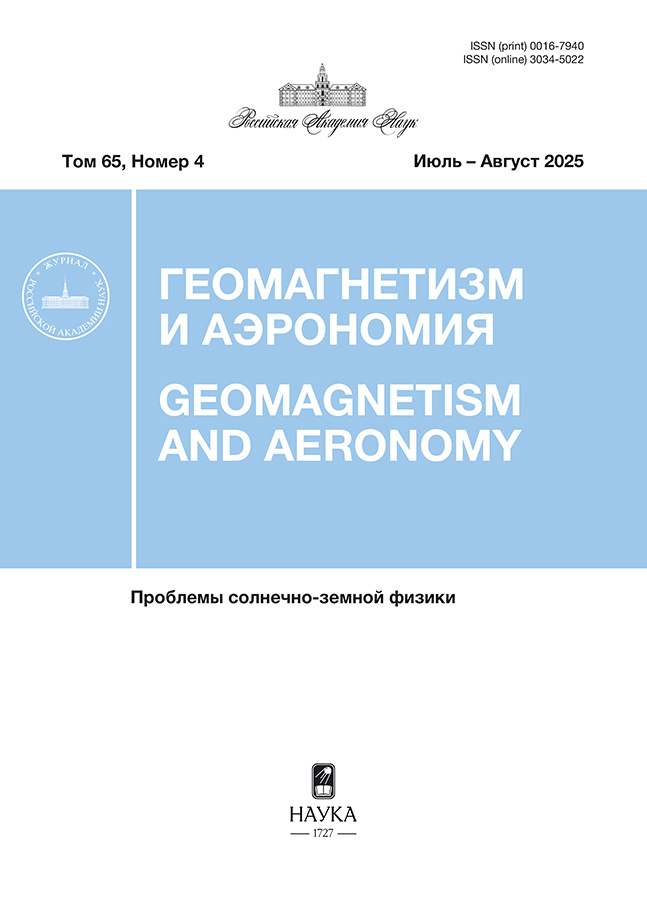Identification of Possible Short-Term Ionospheric Earthquake Precursors for Seismic Events with Intermediate Hypocentrals Depths by Measuring the Standard Parameters of the Mid-Latitude Es Layer
- Authors: Korsunova L.P.1, Hegai V.V.1
-
Affiliations:
- Pushkov Institute of Terrestrial Magnetism, Ionosphere, and Radio Wave Propagation
- Issue: Vol 64, No 2 (2024)
- Pages: 303-311
- Section: Articles
- URL: https://ruspoj.com/0016-7940/article/view/650949
- DOI: https://doi.org/10.31857/S0016794024020139
- EDN: https://elibrary.ru/DYFVKO
- ID: 650949
Cite item
Abstract
Changes in deviations from the background values of the parameters of the sporadic E ionosphere (Es) are studied: the effective (virtual) height h’Es and limiting reflection frequency (foEs). Basically, the analysis was carried based on hourly measurement data from several Japanese ground stations for vertical sounding of the ionosphere in order to identify possible short-term ionospheric earthquake precursors with intermediate (from 60 to 300 km) hypocentral depths. All known events (12 earthquakes, from 1969 to 2022) are considered for which the necessary ionospheric data in the Japan region and magnitudes (M) ranging from 6.5 to 7.6 are available. From coincidence of the maxima in changes in the considered Es characteristics on the same day at pairs of stations separated by hundreds of kilometers, the time of appearance of possible ionospheric earthquake precursors was recorded. According to the ionospheric data available during the preparation period for the studied earthquakes, a tendency has been identified according to which the time the moment of the main influence is anticipated depends on the magnitude of the impending earthquake. Similarities and differences in the responses of the ionosphere to the preparation of surface (crustal) earthquakes and earthquakes with an intermediate hypocentral depth are revealed. Another tendency is also revealed: earlier appearance of the identified earthquake precursors with increasing hypocentral depth for earthquakes with an intermediate hypocentral depth at the same distances from the epicenter to the observation point.
Full Text
About the authors
L. P. Korsunova
Pushkov Institute of Terrestrial Magnetism, Ionosphere, and Radio Wave Propagation
Author for correspondence.
Email: lpkors@rambler.ru
Russian Federation, Moscow, Troitsk
V. V. Hegai
Pushkov Institute of Terrestrial Magnetism, Ionosphere, and Radio Wave Propagation
Email: lpkors@rambler.ru
Russian Federation, Moscow, Troitsk
References
- Апродов В.А. Зоны землетрясений. М.: Мысль, 2000. 461 с.
- Бычков В.В., Корсунова Л.П., Смирнов С.Э., Хегай В.В. Аномалии в ионосфере и электричестве приземного слоя атмосферы перед Камчатским землетрясением 30.01.2016 г. по данным обсерватории “ПАРАТУНКА” // Геомагнетизм и аэрономия. 2017. Т. 57. № 4. С. 532—540. http://dx.doi.org/10.7868/S0016794017040058
- Корсунова Л.П., Легенька А.Д. Обнаружение возможных краткосрочных ионосферных предвестников сильных землетрясений по изменениям ежесуточных характеристик Es // Геомагнетизм и аэрономия. 2021. Т. 61. № 6. С. 803—811. http://dx.doi.org/10.31857/S0016794021050060
- Корсунова Л.П., Хегай В.В. Возможные краткосрочные предвестники сильных коровых землетрясений в Японии по данным наземных станций вертикального зондирования ионосферы // Геомагнетизм и аэрономия. 2018. Т. 58. № 1. С. 94—101. http://dx.doi.org/10.7868/S001679401801008X
- Корсунова Л.П., Хегай В.В. Оценка эффективности использования интегральных суточных характеристик Еs для выделения краткосрочных ионосферных предвестников сильных землетрясений // Геомагнетизм и аэрономия. 2023. Т. 63. № 2. С. 227—237. http://dx.doi.org/10.31857/S0016794022600417
- Михайлов Ю.М. О свойствах предвестников землетрясений в электростатическом поле в приземной атмосфере // Физика Земли. 2007. № 4. С. 76—80.
- Пулинец С.А., Узунов Д.П., Давиденко Д.В., Дудкин С.А., Цадиковский Е.И. Прогноз землетрясений возможен?! М.: Тровант, 2014. 144 с.
- Сидорин А.Я. Предвестники землетрясений. М.: Наука, 1992. 192 с.
- Чавдаров С.С., Часовитин Ю.К., Чернышева С.П., Шефтель В.М. Среднеширотный спорадический слой Е ионосферы. М.: Наука, 1975. 120 с.
- Dabas R.S., Das R.M., Sharma K., Pillai K.G.M. Ionospheric precursors observed over low latitudes during some of the recent major earthquakes // J. Atmos. Sol.-Terr. Phy. 2007. V. 69. № 15. P. 1813—1824. https://doi.org/10.1016/j.jastp.2007.09.005
- Dobrovolsky I.P., Zubkov S.I., Miachkin V.I. Estimation of the size of earthquake preparation zones // Pure Appl. Geophys. 1979. V. 117. № 5. P. 1025—1044. https://doi.org/10.1007/BF00876083
- Hegai V., Zeren Z., Pulinets S. Seismogenic field in the ionosphere before two powerful earthquakes: possible magnitude and observed ionospheric effects (Case study) // Atmosphere. 2023. V. 14. № 5. ID819. https://doi.org/10.3390/atmos14050819
- Liu J.Y., Chen Y.I., Chuo Y.J., Chen C.S. A statistical investigation of pre-earthquake ionospheric anomaly // J. Geophys. Res. Space. 2006. V. 111. № 5. ID A05304. https://doi.org/10.1029/2005JA011333
- Nestorov G.T. A possible ionospheric presage of the Vrancha earthquake of March 4, 1977 // Comptes rendus de l’Academie Вulgare des Sciences. 1979. V. 32. № 4. P. 443—446.
- Perevalova N.P., Sankov V.A., Astafyeva E.I., Zhupityaeva А.S. Threshold magnitude for ionospheric TEC response to earthquakes // J. Atmos. Sol.-Terr. Phy. 2014. V. 108. P. 77—90. http://dx.doi.org/10.1016/j.jastp.2013.12.014
- Perrone L., Korsunova L.P., Mikhailov A.V. Ionospheric precursors for crustal earthquakes in Italy // Ann. Geophys. 2010. V. 28. № 4. P. 941—950. https://doi.org/10.5194/angeo-28-941-2010
- Pulinets S.A., Boyarchuk K.A. Ionospheric precursors of earthquakes. Berlin: Springer, 2005. 315 p. https://doi.org/10.1007/b137616
- Pulinets S., Ouzounov D. The Possibility of Earthquake Forecasting: Learning from nature. Bristol, UK: IOP Publishing Ltd., 2018. 167 p. https://doi.org/10.1088/978-0-7503-1248-6
- Sarkar S., Gwal A.K., Parrot M. Ionospheric variations observed by the DEMETER satellite in the mid-latitude region during strong earthquakes // J. Atmos. Sol.-Terr. Phy. 2007. V. 69. № 13. Р. 1524—1540. https://doi.org/10.1016/j.jastp.2007.06.006
- Sharma D.K., Israil M., Chand R., Rai J., Subrahmanya P., Garg S.C. Signature of seismic activities in the F2 region ionospheric electron temperature // J. Atmos. Sol.-Terr. Phy. 2006. V. 68. № 6. P. 691—696. https://doi.org/10.1016/j.jastp.2006.01.005
- Xia C., Yang S., Xu G., Zhao B., Yu T. Ionospheric anomalies observed by GPS TEC prior to the Qinghai Tibet region earthquakes // Terr. Atmos. Ocean. Sci. 2011. V. 22. № 2. P. 177—185. https://doi.org/10.3319/TAO.2010.08.13.01(TibXS)
Supplementary files















